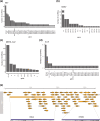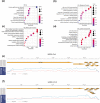Identification and characterization of virus-encoded circular RNAs in host cells
- PMID: 35731570
- PMCID: PMC9455708
- DOI: 10.1099/mgen.0.000848
Identification and characterization of virus-encoded circular RNAs in host cells
Abstract
Emerging evidence has identified viral circular RNAs (circRNAs) in human cells infected by viruses, interfering with the immune system and inducing diseases including human cancer. However, the biogenesis and regulatory mechanisms of virus-encoded circRNAs in host cells remain unknown. In this study, we used the circRNA detection tool CIRI2 to systematically determine the virus-encoded circRNAs in virus-infected cancer cell lines and cancer patients, by analysing RNA-Seq datasets derived from RNase R-treated samples. Based on the thousands of viral circRNAs we identified, the biological characteristics and potential roles of viral circRNAs in regulating host cell function were determined. In addition, we developed a Viral-circRNA Database (http://www.hywanglab.cn/vcRNAdb/), which is open to all users to search, browse and download information on circRNAs encoded by viruses upon infection.
Keywords: RNA-Seq; RNase R; Viral-circRNA Database; host cells; viral circRNA.
Conflict of interest statement
The authors declare that there are no conflicts of interest.
Figures





Similar articles
-
Discovery of Kaposi's sarcoma herpesvirus-encoded circular RNAs and a human antiviral circular RNA.Proc Natl Acad Sci U S A. 2018 Dec 11;115(50):12805-12810. doi: 10.1073/pnas.1816183115. Epub 2018 Nov 19. Proc Natl Acad Sci U S A. 2018. PMID: 30455306 Free PMC article.
-
VirusCircBase: a database of virus circular RNAs.Brief Bioinform. 2021 Mar 22;22(2):2182-2190. doi: 10.1093/bib/bbaa052. Brief Bioinform. 2021. PMID: 32349124
-
Viral Circular RNAs and Their Possible Roles in Virus-Host Interaction.Front Immunol. 2022 Jun 17;13:939768. doi: 10.3389/fimmu.2022.939768. eCollection 2022. Front Immunol. 2022. PMID: 35784275 Free PMC article. Review.
-
Virus-Encoded Circular RNAs: Role and Significance in Viral Infections.Int J Mol Sci. 2023 Nov 20;24(22):16547. doi: 10.3390/ijms242216547. Int J Mol Sci. 2023. PMID: 38003737 Free PMC article. Review.
-
Viruses join the circular RNA world.FEBS J. 2021 Aug;288(15):4488-4502. doi: 10.1111/febs.15639. Epub 2020 Dec 9. FEBS J. 2021. PMID: 33236482 Free PMC article. Review.
Cited by
-
An updated database of virus circular RNAs provides new insights into the biogenesis mechanism of the molecule.Emerg Microbes Infect. 2023 Dec;12(2):2261558. doi: 10.1080/22221751.2023.2261558. Epub 2023 Oct 5. Emerg Microbes Infect. 2023. PMID: 37725485 Free PMC article.
-
Expanding diversity of bunyaviruses identified in mosquitoes.Sci Rep. 2023 Oct 24;13(1):18165. doi: 10.1038/s41598-023-45443-2. Sci Rep. 2023. PMID: 37875565 Free PMC article.
-
Identification, characterization and expression analysis of circRNA encoded by SARS-CoV-1 and SARS-CoV-2.Brief Bioinform. 2024 Jan 22;25(2):bbad537. doi: 10.1093/bib/bbad537. Brief Bioinform. 2024. PMID: 38279648 Free PMC article.
References
Publication types
MeSH terms
Substances
LinkOut - more resources
Full Text Sources

